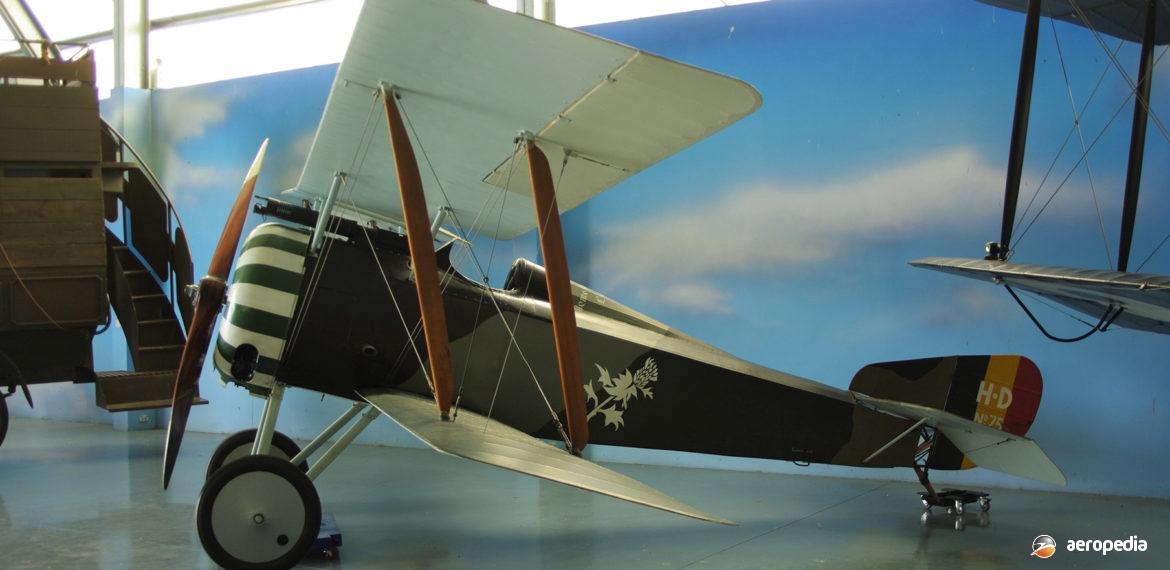Photograph:
Hanriot HD.1 ZK-EAY (c/n 75) at Masterton, New Zealand in April 2015 (David C Eyre)
Country of origin:
France
Description:
Single-seat fighting scout
Power Plant:
One 97 kw (130 hp) Le Rhone 9Jb nine-cylinder rotary engine with a displacement of 15 litres (911.4 cub in) and weighing 146.5 kg (323 lb)
Specifications:
- Wingspan [upper wing]: 8.56 m (27 ft 11 in)
- Wingspan: [lower wing]: 7.07 m ( 23 ft 2½ in)
- Length: 5.85 m (19 ft 2¼ in)
- Height: 2.94 m (9 ft 7½ in)
- Wing area: 18.2 m² (195.9 sq ft)
- Max speed at sea level: 184 km/h (115 mph)
- Max speed at 2,000 m (6,560 ft): 178 km/h (111 mph)
- Time to 1,000 m (3,280 ft): 2 mins 58 secs
- Time to 2,000 m (6,560 ft): 6 mins 3 sec
- Time to 4,000 m (13,125 ft): 19 mins 30 sec
- Time to 5,000 m (16,400 ft): 32 mins
- Time to 6,000 m (19,685 ft): 60 mins
- Ceiling: 6,000 m (20,670 ft)
- Range: 360 km (224 miles)
- Endurance: 2 hrs 30 mins
- Fuel capacity: 136 litres (30 Imp gals)
- Empty weight: 446 kg (983 lb)
- Loaded weight: 652 kg (1,437 lb)
Armament:
One 7.7 mm (0.303 in) Vickers machine gun
History:
In 1916 the Societe Anonyme de Appareils d’Aviation Hanriot built a fighter for operations in World War I, this aircraft, the HD.1, being designed by Emile Dupont and being the Company’s first fighter design. It was powered by an 82 kw (110 hp) Le Rhone 9J rotary engine. It was armed with a synchronised 7.7 mm (0.303 in) Vickers machine gun, although a number of aircraft had two Vickers machine guns installed. The aircraft was popular, being small and agile, but did not receive an order for the Aviation Militaire, France’s air arm, as at that time the Spad S.VII was in production and was considered to provide aerial supremacy.
However, the HD.1 did receive an order from Italy where manufacture was undertaken by the Societa Nieuport Macchi under licence, 125 examples being delivered to the Aeronautica del Regio Esercito in 1917, a further 706 in 1918 and a further 70 being completed prior to the Armistice. The type was also chosen for the Belgian Air Force, Hanriot supplying 79 in 1917. The type continued in service in both Italy and Belgium until the mid 1920s. After the type’s withdrawal from service in Italy, 16 were supplied to the Swiss Air Force where they continued in service until 1930.
Power plant in 1917 was usually the Le Rhone rotary engine, the 82 kw (110 hp) 9J, the 90 kw (120 hp) 9Jb in 1918 driving a Ratamanoff propeller, and the 90 kw to 97 kw (120 hp to 130 hp) 9Jb driving an Éclair propeller.
The HD.1 mainly saw service in Belgium, the first aircraft reaching its Air Force on 22 August 1917 and being assigned to the 1ere Escadrille de Chasse, replacing Nieuport XXIIIs, the first aircraft being allotted to Belgium’s 5th ranking ace Jean Olieslagers who indicated a preference for the Nieuport. The HD.1 was then handed over to Andre Demeulemeester, who refused to accept the aircraft, and it was subsequently given to his wingman Willy Coppens.
Initially the machine gun on the Belgian machines was mounted on the port side of the fuselage but this was later centralised. Coppens went on to become Belgium’s greatest exponent of the Hanriot and its leading ace, using a number of aircraft until he was hit by shrapnel on 14 October 1918 when attacking an observation balloon and crash landed. Hanriots he is known to have flown included No 9, No 24, No 6, No 23 and No 45.
In 1918 several HD.1s were purchased by the United States Navy(USN) and these were operated along the French coast. A further ten were manufactured in the United States by the Naval Aircraft Factory after the Armistice.
A number of HD.1 examples have survived. One (653) has been placed on display at the Swiss Air Force Museum at Dubendorf in Switzerland. Another has been placed on display at the US Navy Museum at Pensacola, Florida. Another, which was operated in the 1920s by Charles Nungesser for his barnstorming tour of the United States, has been placed on display at the Planes of Fame Museum in Chino, California. Another was a Macchi-built machine at the Ecuador Air Force Museum in Quito; and one has been placed on display at the Brussel’s Air Museum in Belgium.
One (No 75) was operated by 1 em Escadrille de Chasse Aviation, Militaire Belge in World War I. Post War in 1922 it was flown in an International Aerobatic championship at Nice in France by Willy Coppens who lost a leg during World War I. It was later obtained by Richard Shuttleworth and operated by the Shuttleworth Collection at Old Warden with the British registration G-AFDX. It was badly damaged in an accident in 1939. In 1963 it was sold to Marvin Hand in California and restored to airworthiness, flying in the Sonoma Valley in 1968.
In 1979 the aircraft was donated to the RAF Museum, restored at Cardington and placed on display in the main hall until placed in the Graham White factory. In late 2012 the HD.1 and a Farman F.40, which had been in storage for the RAF Museum, were exchanged with The Vintage Aviator Limited (TVAL) in Wellington, NZ for a Sopwith Snipe, an RAF RE.8 and an Albatros D.Va, the two aircraft leaving the United Kingdom in December 2012 and being shipped to Masterton for restoration to fly. Work commenced to make them airworthy, the Hanriot becoming ZK-EAY in early 2014. In early 2016 this aircraft had its markings changed to that of an aircraft of the Belgian Air Force in World War I.

